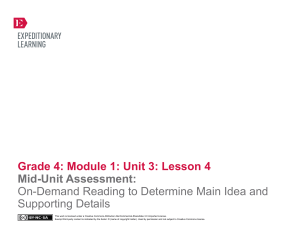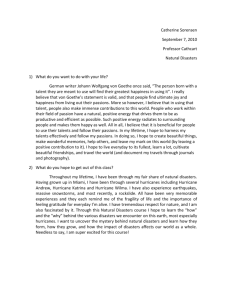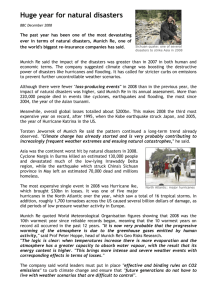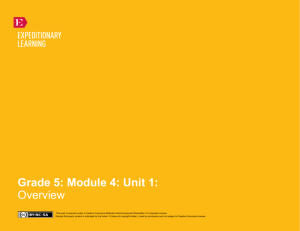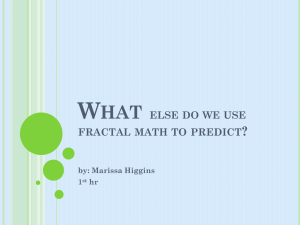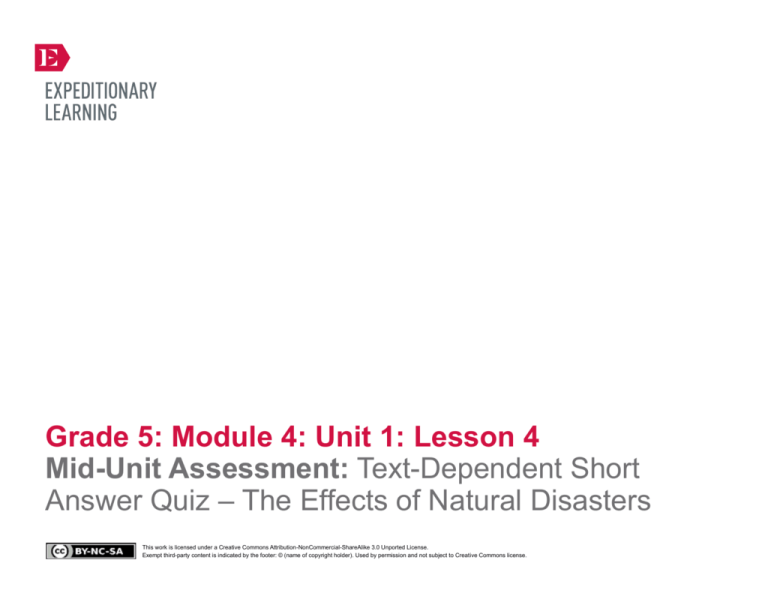
Grade 5: Module 4: Unit 1: Lesson 4
Mid-Unit Assessment: Text-Dependent Short
Answer Quiz – The Effects of Natural Disasters
This work is licensed under a Creative Commons Attribution-NonCommercial-ShareAlike 3.0 Unported License.
Exempt third-party content is indicated by the footer: © (name of copyright holder). Used by permission and not subject to Creative Commons license.
GRADE 5: MODULE 4: UNIT 1: LESSON 4
Mid-Unit Assessment:
Text-Dependent Short Answer Quiz – The Effects of Natural Disasters
Long-Term Targets Addressed (Based on NYSP12 ELA CCLS)
I can explain what a text says using quotes from the text. (RI.5.1)
I can explain important relationships between people, events, and ideas in a historical, scientific, or technical text using specific
details in the text. (RI.5.3)
I can determine the meaning of academic words or phrases in an informational text. (RI.5.4)
I can determine the meaning of content words or phrases in an informational text. (RI.5.4)
Supporting Learning Targets
Ongoing Assessment
• I can explain the relationship between scientific concepts about earthquakes and hurricanes using
specific details from text.
• Mid-Unit 1 Assessment
• Tracking My Progress recording form
• I can determine the meaning of new words from context about natural disasters.
• I can reflect on my learning.
Copyright © 2013 by Expeditionary Learning, New York, NY. All Rights Reserved.
NYS Common Core ELA Curriculum • G5:M4:U1:L4 • June 2014
•
1
GRADE 5: MODULE 4: UNIT 1: LESSON 4
Mid-Unit Assessment:
Text-Dependent Short Answer Quiz – The Effects of Natural Disasters
Agenda
1. Opening
A. Checking Independent Reading Homework (8
minutes)
B. Review Learning Targets (2 minutes)
2. Work Time
A. Mid-Unit Assessment (20 minutes)
B. Read Aloud and Chunking the Text: Relationships
between Science Concepts and Earthquakes (15
minutes)
C. Tracking My Progress (10 minutes)
Teaching Notes
• Review and be familiar with Mid-Unit Assessment: Text-Dependent Short-Answer Quiz—The Effects of
Natural Disasters
• In this lesson, students formally self-assess on their progress towards the learning targets.
• Students read the text “How Do Hurricanes Form?” during their mid-unit assessment (note that this
text has a similar name to the article “How Does a Hurricane Form?” from Lesson 3. However, the type
and presentation of information is different in each article.) They then hear the text “Earthquakes!” read
aloud by the teacher and do some work with key vocabulary in preparation for Lesson 5. The students
reread these texts for homework, so be sure to have a second, clean “How Do Hurricanes Form?” text
prepared for students to take home with them.
• The text—“Earthquakes!”—is significantly above grade level; hence it is read aloud before students
reread for homework.
3. Closing and Assessment
A. Debrief: Sharing Reflections (5 minutes)
4. Homework
A. Reread the articles “Earthquakes!” and “How Do
Hurricanes Form?”
B. Add new information from the articles to the
Earthquakes and Hurricanes note-catchers
Copyright © 2013 by Expeditionary Learning, New York, NY. All Rights Reserved.
NYS Common Core ELA Curriculum • G5:M4:U1:L4 • June 2014
•
2
GRADE 5: MODULE 4: UNIT 1: LESSON 4
Mid-Unit Assessment:
Text-Dependent Short Answer Quiz – The Effects of Natural Disasters
Lesson Vocabulary
Materials
determine, relationships, context,
reflect; exponential
• Journals
• Students’ independent reading books
• What Do We Know about Natural Disasters? anchor chart (Lesson 1)
• Things Close Readers Do anchor chart (from Module 3)
• “How Do Hurricanes Form?” (one per student, for assessment; one clean copy per student, for homework)
• Mid-Unit Assessment: Text-Dependent Short-Answer Quiz—The Effects of Natural Disasters (one per student)
• “Earthquakes!” text (one per student)
• Tracking My Progress, Mid-Unit 1 recording form (one per student)
• Earthquake Concepts note-catcher (begun in Lesson 2)
• Hurricane Concepts note-catcher (begun in Lesson 3)
Copyright © 2013 by Expeditionary Learning, New York, NY. All Rights Reserved.
NYS Common Core ELA Curriculum • G5:M4:U1:L4 • June 2014
•
3
GRADE 5: MODULE 4: UNIT 1: LESSON 4
Mid-Unit Assessment:
Text-Dependent Short Answer Quiz – The Effects of Natural Disasters
Opening
Meeting Students’ Needs
A. Checking Independent Reading Homework (8 minutes)
• Consider partnering ELL students
with other students who speak the
same L1.
• Ask students to take out their journals as well as their independent reading book with evidence flags from homework.
• Focus their attention on the What Do We Know about Natural Disasters? anchor chart they started in the first
lesson. Ask students to turn to a partner and share a piece of evidence from their independent reading book that they flagged
for homework that could added to the anchor chart.
• Call on several students to share their evidence. Add them to the class anchor chart and invite students to do the same in
their anchor charts in their journals as well as add any others they may have found evidence for during their reading.
B. Review Learning Targets (2 minutes)
• Review the first two learning targets:
* “I can explain the relationship between scientific concepts about earthquakes and hurricanes using specific details from
text.”
* “I can determine the meaning of new words from context about natural disasters.”
• Students who struggle with
language may need warning that
they will be called upon to share
aloud. Give those students a few
minutes to prepare what they will
say in front of the whole class.
• Provide nonlinguistic symbols (e.g.,
a magnifying glass for determine,
two connected rings for
relationships) for academic words
in learning targets.
• Remind students they have been working on these learning targets in the past few lessons; there is no trick to today’s
assessment.
• Ask several students to restate each target in their own words. Be sure their restatements give the meaning of the words:
determine (figure out), relationships (what things have to do with one another or connections), context (meaning from the
text).
Copyright © 2013 by Expeditionary Learning, New York, NY. All Rights Reserved.
NYS Common Core ELA Curriculum • G5:M4:U1:L4 • June 2014
•
4
GRADE 5: MODULE 4: UNIT 1: LESSON 4
Mid-Unit Assessment:
Text-Dependent Short Answer Quiz – The Effects of Natural Disasters
Work Time
Meeting Students’ Needs
A. Mid-Unit Assessment (20 minutes)
• Consider providing a chunked
version (a few paragraphs) of the
article “How Do Hurricanes Form?”
to students who struggle with
reading grade-level text.
• Tell students that for the Mid-Unit Assessment they will read independently one new article about hurricanes. They will then
answer questions about what they have read. Congratulate them on how hard they have been working on reading complex
texts.
• Review with students strategies for reading new texts, such as the ones listed on the Things Close Readers Do anchor
chart from previous modules.
• Distribute the article “How Do Hurricanes Form?” as well as the Mid- Unit 1 Assessment: Text-Dependent
Short-Answer Quiz—The Effects of Natural Disasters.
• Review the instructions with students. Invite students to quickly scan the assessment. Tell them that they will have about 20
minutes to read the article and complete the questions on the assessment. Address any clarifying questions.
• Provide extended time to complete
the mid-unit assessment for
identified ELL or IEP students who
struggle with language.
• Give students 20 minutes to work independently. Circulate to supervise and redirect as needed. Since this is a formal ondemand assessment, do not provide support other than formally approved accommodations.
• If students finish the assessment before the 20 minutes is up, encourage them to do one of the following:
1. Add new information to the appropriate columns of the Hurricanes anchor chart in your journals.
2. Add new words to your glossary.
3. Continue reading your independent reading book.
• Collect students’ Mid-Unit Assessments.
Copyright © 2013 by Expeditionary Learning, New York, NY. All Rights Reserved.
NYS Common Core ELA Curriculum • G5:M4:U1:L4 • June 2014
•
5
GRADE 5: MODULE 4: UNIT 1: LESSON 4
Mid-Unit Assessment:
Text-Dependent Short Answer Quiz – The Effects of Natural Disasters
Work Time (continued)
Meeting Students’ Needs
B. Read Aloud and Chunking the Text: Relationships between Science Concepts about Earthquakes
(15 minutes)
• Students who struggle with reading
complex text may need the text read
aloud to them several times.
• Distribute the article “Earthquakes!” to students. Tell them that they are going to read this article together as a class in
order to prepare for the next lesson—where they will be adding information to the Concepts note-catchers. Remind students
to follow along silently as you read aloud.
• Read from the start of the article through the phrase “… In a level 8 earthquake, many buildings will fall down.”
• Remind students that when they are reading difficult text, it is often helpful to chunk it: to read a bit, then stop to think, talk,
or write. Ask students to think about and then discuss with a partner:
• Consider giving the Earthquakes!
article in paragraphs (chunks) to
students that struggle reading a lot
of text at once.
* “What does the word exponential mean?”
• Call on a few partners to share their discussion. Listen for: “It means that the next number in the scale is 10 times as strong
as the one before. So an earthquake rated 7 is 10 times bigger than one rated 6.” Be sure students understand that this is the
way the strength of an earthquake is measured and that usually the stronger the earthquake, the more damage is caused,
making it more likely to be a disaster.
• Focus students back on the text. Begin reading again starting with, “Because most of the Earth is covered by oceans …” until
the end of the article.
• Ask students to think about and discuss with another partner:
* “What is a tsunami, and how is it formed?”
• Remind them to refer to their text for evidence as they discuss with their partner.
• Invite a few students to share their thinking about tsunamis. Listen for: “A huge wave caused by an earthquake in the
ocean,” and “Tsunamis are formed when earthquakes happen in the ocean. Water pulls together and it forms a huge wave.”
• Tell students that if tsunamis reach land, they often cause major damage and are considered a disaster.
• Tell students they will reread both texts they worked with today as a part of their homework. They will look for more
evidence to add to their note-catchers.
Copyright © 2013 by Expeditionary Learning, New York, NY. All Rights Reserved.
NYS Common Core ELA Curriculum • G5:M4:U1:L4 • June 2014
•
6
GRADE 5: MODULE 4: UNIT 1: LESSON 4
Mid-Unit Assessment:
Text-Dependent Short Answer Quiz – The Effects of Natural Disasters
Work Time (continued)
Meeting Students’ Needs
C. Tracking My Progress (10 minutes)
• Consider allowing students who
struggle with written language to
dictate their Tracking My
Progress to the teacher or a
partner.
• Introduce the final learning target: “I can reflect on my learning.” Focus on the word reflect and ask students for suggestions
about what this means. Listen for them to share ideas such as: “look back at my work to think about what I did,” “how I did,”
“what I am having trouble with,” “what I am doing well,” etc.
• Remind students that they have done this type of self-assessment at the end of most mid-unit and end of unit assessments
during previous modules.
• Distribute the Tracking My Progress, Mid-Unit 1 recording form. Read through the tracker and provide clarification as
necessary for students.
• Ask students to independently complete their Tracking My Progress forms and keep this sheet to refer to during the debrief.
Copyright © 2013 by Expeditionary Learning, New York, NY. All Rights Reserved.
NYS Common Core ELA Curriculum • G5:M4:U1:L4 • June 2014
•
7
GRADE 5: MODULE 4: UNIT 1: LESSON 4
Mid-Unit Assessment:
Text-Dependent Short Answer Quiz – The Effects of Natural Disasters
Closing and Assessment
Meeting Students’ Needs
A. Debrief: Sharing Reflections (5 minutes)
• Strategically partner students so
that students who struggle with
language are paired with students
who have stronger language skills.
• Ask students to share with a partner the reflections on their Tracking My Progress recording forms.
• As time permits, invite several students to share out whole group. Collect students’ Tracking My Progress forms and return
their Earthquake Concepts and Hurricane Concepts note-catchers.
Homework
Meeting Students’ Needs
• Reread the articles “Earthquakes!” and “How Do Hurricanes Form?”
• Consider providing audio
recordings of the articles to students
who struggle with reading complex
text.
• Add new information from the articles to the Earthquake and Hurricane Concepts note-catchers in your journal.
(from Lesson 2).
• Be prepared to share your note-catchers.
Note: Review students’ Mid-Unit 1 Assessments and Tracking My Progress forms.
Copyright © 2013 by Expeditionary Learning, New York, NY. All Rights Reserved.
• Provide pre-highlighted articles for
students who have difficulty
determining details to add to their
note-catchers.
NYS Common Core ELA Curriculum • G5:M4:U1:L4 • June 2014
•
8
Grade 5: Module 4: Unit 1: Lesson 4
Supporting Materials
This work is licensed under a Creative Commons Attribution-NonCommercial-ShareAlike 3.0 Unported License.
Exempt third-party content is indicated by the footer: © (name of copyright holder). Used by permission and not subject to Creative Commons license.
GRADE 5: MODULE 4: UNIT 1: LESSON 4
Mid-Unit 1 Assessment:
Text-Dependent Short-Answer Quiz – The Effects of Natural Disasters
Name:
Date:
Instructions
1. Read the article “How Do Hurricanes Form?”
2. Determine the gist of the article—what is it mostly about?
3. Skim the assessment questions.
4. Reread the article, thinking about the assessment questions.
5. Answer the questions.
6. Be sure to cite evidence from the text to support your answers.
Copyright © 2013 by Expeditionary Learning, New York, NY. All Rights Reserved.
NYS Common Core ELA Curriculum • G5:M4:U1:L4 • June 2014 •
10
GRADE 5: MODULE 4: UNIT 1: LESSON 4
Mid-Unit 1 Assessment:
Text-Dependent Short-Answer Quiz – The Effects of Natural Disasters
How Do Hurricanes Form?
How Hurricanes Work
Hurricanes are huge storms! They can be up to 600 miles
across and have strong winds spiraling inward and upward
at speeds of 75 to 200 mph. Each hurricane lasts for over a
week, moving 10-20 miles per hour over the open ocean.
With warm air at its center, a hurricane is different from
extratropical cyclones, which are the most common type of
storm in the United States. The center of the storm is the
calmest part. It is called the eye and has only light winds
and fair weather. The low level storm winds blow
counterclockwise around the eye in the Northern
Hemisphere (clockwise in the Southern Hemisphere).
Above 9 km, winds spiral outwards and clockwise in the
Northern Hemisphere.
Copyright © 2013 by Expeditionary Learning, New York, NY. All Rights Reserved.
NYS Common Core ELA Curriculum • G5:M4:U1:L4 • June 2014 •
11
GRADE 5: MODULE 4: UNIT 1: LESSON 4
Mid-Unit 1 Assessment:
Text-Dependent Short-Answer Quiz – The Effects of Natural Disasters
Where and When Do They Form?
Hurricanes do an important job for the Earth. They help move heat from warm tropical places to the
cooler temperate zone. To do this, they typically form between 5 to 15 degrees latitude north and
south of the equator. Then, they thunder across the warm oceans of the world such as the Atlantic, the
Gulf of Mexico, the Caribbean, and the Western Pacific Ocean (where they are called typhoons), up to
higher latitudes.
Hurricanes happen when the oceans have been warmed during summer months. In the North
Atlantic, hurricane season is from June 1 to November 30, but most hurricanes happen during the fall.
Copyright © 2013 by Expeditionary Learning, New York, NY. All Rights Reserved.
NYS Common Core ELA Curriculum • G5:M4:U1:L4 • June 2014 •
12
GRADE 5: MODULE 4: UNIT 1: LESSON 4
Mid-Unit 1 Assessment:
Text-Dependent Short-Answer Quiz – The Effects of Natural Disasters
Storm Surge
As a hurricane’s winds spiral around and around the storm, they push water into a mound at the
storm’s center. This mound of water becomes dangerous when the storm reaches land because it
causes flooding along the coast. The water piles up, unable to escape anywhere but on land as the
storm carries it landward. A hurricane will cause more storm surge in areas where the ocean floor
slopes gradually.
When high tide happens at the same time as a storm surge, the combination of the two is called storm
tide. During a storm tide, the water level may be 20 feet or more above normal. This causes huge
floods. Storm tide is especially dangerous for islands or coastal areas where even a few feet of surge
may cause large areas of flooding.
FK: 7.6
Lexile: 1050
2003 Copyright, University Corporation for Atmospheric Research Illustrations by Lisa Gardiner, UCP/SPARK
Copyright © 2013 by Expeditionary Learning, New York, NY. All Rights Reserved.
NYS Common Core ELA Curriculum • G5:M4:U1:L4 • June 2014 •
13
GRADE 5: MODULE 4: UNIT 1: LESSON 4
Mid-Unit 1 Assessment:
Text-Dependent Short-Answer Quiz – The Effects of Natural Disasters
Questions:
1. The text says, “It is called the eye and has only light winds and fair weather.” What does fair mean
in this sentence? How did you figure this word out?
2. Why would a hurricane not form in Alaska? Quote the text in your answer.
3. What does the word season mean in the text? Be sure to use evidence from the text to support your
answer.
Copyright © 2013 by Expeditionary Learning, New York, NY. All Rights Reserved.
NYS Common Core ELA Curriculum • G5:M4:U1:L4 • June 2014 •
14
GRADE 5: MODULE 4: UNIT 1: LESSON 4
Mid-Unit 1 Assessment:
Text-Dependent Short-Answer Quiz – The Effects of Natural Disasters
4. Place in order the steps that lead to a storm surge.
1. ______
Water piles up, unable to escape anywhere but on land.
2. ______
Water is pushed into a mound at the center of the storm.
3. ______
The hurricane causes a storm surge.
4. ______
The storm reaches land.
5. ______
Hurricane winds spiral around the storm.
Copyright © 2013 by Expeditionary Learning, New York, NY. All Rights Reserved.
NYS Common Core ELA Curriculum • G5:M4:U1:L4 • June 2014 •
15
GRADE 5: MODULE 4: UNIT 1: LESSON 4
Mid-Unit 1 Assessment:
Text-Dependent Short-Answer Quiz – The Effects of Natural Disasters
Answers for Teacher Reference
Questions:
1. The text says, “It is called the eye and has only light winds and fair weather.” What does fair mean
in this sentence? How did you figure this word out? (RI.5.4)
Fair means calm or nice weather. I figured this out because the article says the center,
the eye, of the storm is the calmest part of the storm.
2. Why would a hurricane not form in Alaska? Quote the text in your answer. (RI.5.1)
A hurricane would not form in Alaska because the article says they typically form near
the equator; they move heat from warm tropical areas and move across warm oceans.
3. What does the word season mean in the text? Be sure to use evidence from the text to support your
answer.
A season is a time of year that something happens. I figured this out because the article
says that, “hurricane season is from June 1 to November 30, but most hurricanes
happen during the fall.” “Fall” is also a season or time of year.
4. Place in order the steps that lead to a storm surge.
4
2
5
3
1
Copyright © 2013 by Expeditionary Learning, New York, NY. All Rights Reserved.
NYS Common Core ELA Curriculum • G5:M4:U1:L4 • June 2014 •
16
GRADE 5: MODULE 4: UNIT 1: LESSON 4
“Earthquakes!”
Earthquakes happen when the moving tectonic plates that make up the surface of the Earth move
apart or bump into each other, or slide under each other. This movement tears apart the surface of the
Earth, or crunches it up. Most often, this just means a little shaking for a few seconds, and nothing
very serious happens.
Several times a year, though, somewhere in the world there is enough movement to really shake the
earth a lot, and the earthquake is serious enough to knock down buildings. When the buildings fall on
people, many people can be killed in a few minutes. The strongest earthquakes can break trees in half.
The Richter scale (or ML scale) rates earthquakes on an exponential scale, so that if an earthquake is
rated 1, you can hardly feel it, but an earthquake rated 2 is ten times as strong as an earthquake rated
1, and an earthquake rated 3 is ten times as strong as an earthquake rated 2. Only a few people feel a
level 1 earthquake. In a level 2 earthquake, a few people who are resting may feel it, especially if
they’re near the top of a tall building. Nearly everyone will feel a level 5 earthquake, and some dishes
and windows will break. At level 6, heavy furniture moves around, and many people will feel
frightened, but there’s not really much damage. In a level 8 earthquake, many buildings will fall down.
Because most of the Earth is covered by oceans, earthquakes often happen in the ocean. Usually this
just shakes the water and people don’t notice. But sometimes the water pulls all together into a huge
wave called a tsunami (tsoo-NAMM-ee).
Because at least some other planets, like Mars, probably have tectonic plates like Earth, they probably
also have earthquakes.
Lexile: 1240 (*sentence length 20.13, impacting Lexile)/FK: 8.2
From Karen Carr, Kidipede - History for Kids, Copyright © 2013 (http://www.historyforkids.org) Reprinted by permission of the author.
Copyright © 2013 by Expeditionary Learning, New York, NY. All Rights Reserved.
NYS Common Core ELA Curriculum • G5:M4:U1:L4 • June 2014 •
17
GRADE 5: MODULE 4: UNIT 1: LESSON 4
Tracking My Progress:
Mid-Unit 1
Name:
Date:
Learning Target: I can explain the relationship between scientific concepts about earthquakes and
hurricanes using specific details from text.
1. The target in my own words is:
2. How am I doing? Circle one.
I need more help
to learn this.
I understand
some of this.
I am on my way!
3. The evidence to support my self-assessment is:
Copyright © 2013 by Expeditionary Learning, New York, NY. All Rights Reserved.
NYS Common Core ELA Curriculum • G5:M4:U1:L4 • June 2014 •
18
GRADE 5: MODULE 4: UNIT 1: LESSON 4
Tracking My Progress:
Mid-Unit 1
Name:
Date:
Learning Target: I can determine the meaning of new words from context about natural disasters.
1. The target in my own words is:
2. How am I doing? Circle one.
I need more help
to learn this.
I understand
some of this.
I am on my way!
3. The evidence to support my self-assessment is:
Copyright © 2013 by Expeditionary Learning, New York, NY. All Rights Reserved.
NYS Common Core ELA Curriculum • G5:M4:U1:L4 • June 2014 •
19

